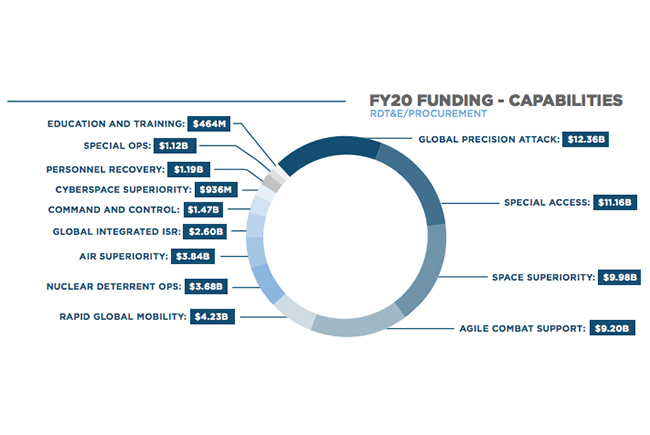
This chart breaks down how the Air Force plans to spend its proposed fiscal 2020 budget on acquisition. The largest section, global precision attack, includes fighter aircraft. Air Force graphic.
The Air Force will spend the bulk of its fiscal 2020 acquisition dollars on global precision attack programs over special access programs, a role reversal from last year, according to a new report from the service released Tuesday.
The annual acquisition report, which covers fiscal 2019 spending and the 2020 request for the service’s major programs, highlights both the funding amounts and schedules for individual weapons systems. For 2020, the Air Force expects to spend its biggest chunk, $12.36 billion on Global Precision Attack programs, or fighters and munitions, and the second highest total of $11.16 billion on classified special access programs. This is compared to last year’s report detailing $10.21 billion on special access and $9.93 billion on global precision attack.
The next largest pots of money are: $9.98 billion for space superiority, $9.2 billion on agile combat support, $4.23 billion on rapid global mobility, $3.84 billion on air superiority, and $3.68 billion on nuclear deterrence.
The Air Force has 51 acquisition category one, or ACAT1, programs. These are the largest programs by spending in the service. Of these, 11 are over cost, 19 are under cost, and 21 are without a cost baseline. The worst examples of over cost programs are the mission planning system, increment five, which is 16 percent over. The F-15 Eagle Passive/Active Warning and Survivability System and the force element terminal section of the Family of Advanced Beyond-Line-of-Sight Terminals for satellite communication are both 14 percent over cost. The report notes a cost improvement on the MQ-9 Reaper system, which has improved by 8 percent from the previous report.
There are eight ACAT1 programs that are over schedule as well, with the worst offender being the Family of Advanced Beyond-Line-of-Sight Terminals at 96 months over original schedule.
The Air Force is using the report to highlight its push to improve the acquisition timeline, under its 2018 Century Challenge to strip 100 years out of the acquisition process for its programs. William Roper, the assistant secretary of the Air Force for acquisition, writes in the report the service is more than 70 percent to that goal.
“As excited as I am to share a portion of the work we have accomplished in the past year, I am more excited for next year’s report when the results of speed with discipline will come to fruition,” Roper said. “In Air Force acquisition, we buy everything from stealth bombers to hospital blankets. Critical thinking is necessary to tailor the traditional, generic acquisition approach that has long overshadowed our programs.”